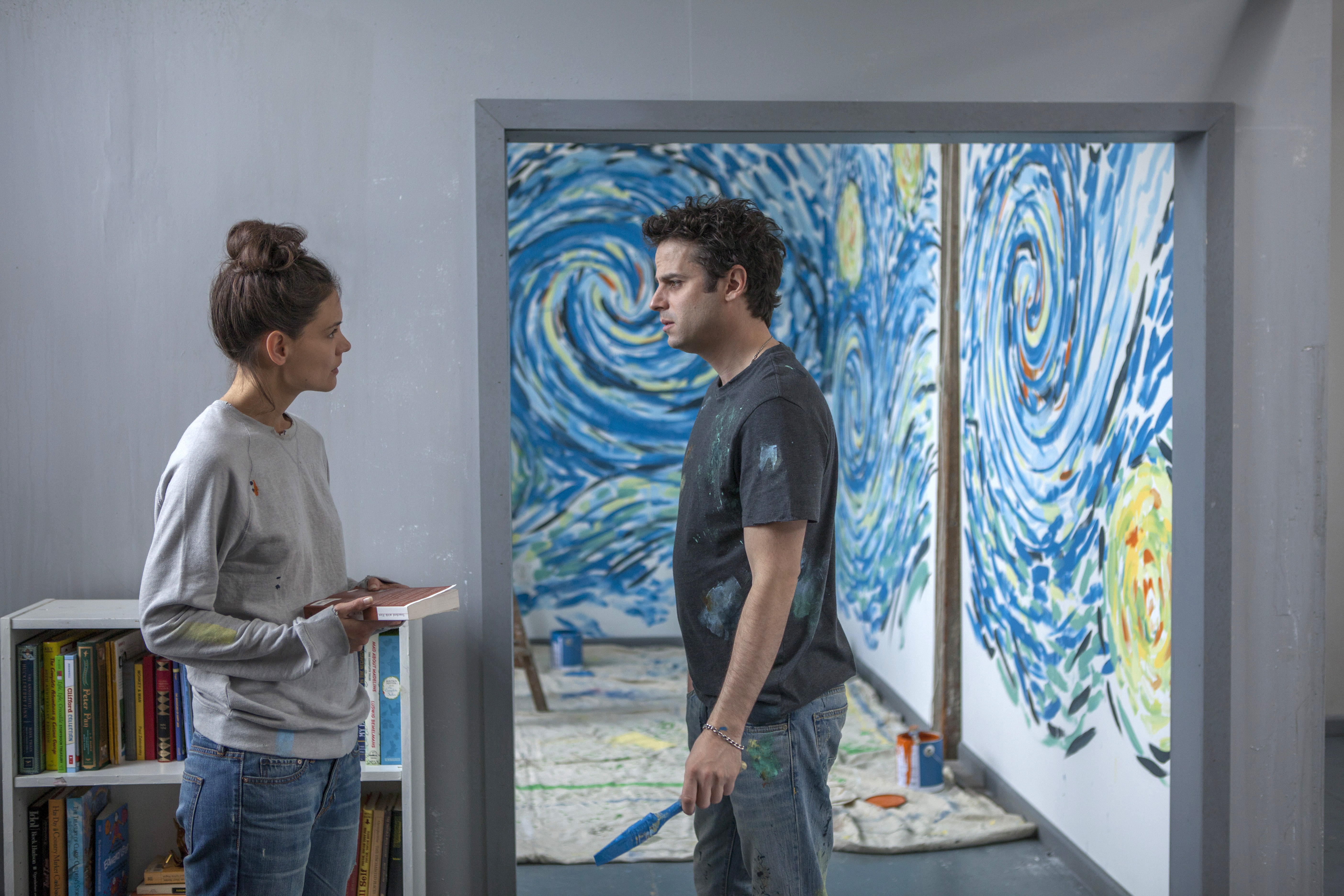Ask the Director: How does “Touched with Fire” present an insider’s perspective of bipolar?
Touched with Fire (2016) presents a portrait of bipolar disorder through the eyes of two poets who fall in love and push each other’s mania to extremes in the blaze of shared passion and creativity. The most unusual thing about the film is its ambivalent, multi-faceted take on bipolar, which it explores from an insider’s point of view. Executive produced by Spike Lee, Touched with Fire is directed, written, edited and scored by Paul Dalio, who based the story (the first feature he’s directed) closely on his own experiences of being diagnosed with and managing bipolar. Dalio told ScreenPrism that he wanted to express all of “the beauty and the horror” of the bipolar condition as he lived it, and he hopes the story will help people view those diagnosed with bipolar in a new light.
“I hope that they’ll be able to see through these people’s eyes because, if they do, they’ll see the beauty through their eyes. And they won’t look at [people with bipolar] the same way as they would if all they know is what they read in a clinical book and all they see is twitches and ‘crazy,’ wide, bloodshot eyes.” Dalio uses Van Gogh’s Starry Night as a central unifying image in the film, revealing to us “the view through Van Gogh’s sanitarium window, what that sky looked like, and how much of humanity’s most beloved image of the sky came from those crazy, bloodshot eyes. And if [audiences] see through those eyes, they won’t look at them as crazy, bloodshot eyes anymore. They’ll look at them as magical eyes, and that can reduce the stigma.”

Director Paul Dalio on the set of Touched with Fire (2016)
As a filmmaker who is bipolar, Dalio feels it is his special privilege and responsibility to tell this story through an insider’s view. “It’s impossible to portray bipolar as it is through their eyes if you don’t have it,” he said. While other filmmakers may have firsthand experiences with bipolar, such as watching loved ones and relatives go through the experience, “they’re still looking at them from the outside, and they’re still in some way shaded by all the clinical books and all the presumptions of what’s going on in their mind, and so it’s still a little bit distancing. You might feel sorry for them. You might even feel love for them, but in a pathetic way, in a pitying way, like they’re a sick person. You won’t see the magnificence in them.” Dalio felt the best way to translate his own bipolar journey to screen was by framing it as a love story between two creatives who “bring out all the beauty and the horror in each other in this passionate boundless love, which builds and builds in intensity and beauty to the point where it burns too bright to sustain.”
Touched with Fire’s Carla (Katie Holmes) and Marco (Luke Kirby) meet in the hospital and bond over their similarities, finding inspiration in Kay Redfield Jamison’s Touched with Fire: Manic-Depressive Illness and the Artistic Temperament, which discusses the link between great artists and bipolar, and in Starry Night. Later, they abandon their families and medication to pursue the emotional heights of a manic state together, but their resulting recklessness as well as their depressive periods threaten their romance and make it challenging for them to establish a stable lifestyle as couple.

Carla (Katie Holmes) and Marco (Luke Kirby) in Touched with Fire (2016)
Dalio told ScreenPrism that both characters represent different stages and aspects of his own journey. “When I first went manic, I was very lost like Carla [Holmes] was, and I was disoriented. You realize you’re not going to be the same person you used to be, and you don’t have much hope from what they tell you you’re gonna be—because they tell you you have this genetic defect.”
A pivotal moment in Dalio’s was discovering Jamison’s book. Dalio later become friends with Jamison, who appears in a scene of Touched with Fire, playing herself. “The book is the first time that I found a word or a phrase that described me in a way that awakened something proud in me and awakened something beautiful in me,” Dalio said. He felt dissatisfied with the vocabulary available to describe his condition: terms like “bipolar disorder,” “manic depressive,” and “mentally ill” were “the only terms I had to choose from, and me not understanding this thing inside me, suddenly seeing ‘touched with fire’ burning bright through all those labels, in a book of poetry about the gifts behind it, is what shifted my emotion and my consciousness, launch[ing] me on the journey back and forth between the horror and the beauty, trying to find some reconciliation between the two.”
But while Touched with Fire “was this beautiful beacon of hope” for Dalio, embracing the “touched with fire” identity also led him to a dangerous idealization of bipolar. “I did embody and absorb and appreciate the beauty of it, but to my own destruction, as I romanticized it,” he said. “I broke off from the meds, broke off from humanity.”
Kirby’s Marco expresses this strand of Dalio’s experience, as Marco cherishes his manic state, believing it to be his source of creativity and even genius. Marco’s rap-poetry before cheering crowds in the film’s opening is based closely on Dalio’s actual experiences. “I’d go to those rap clubs and rap under the rap name ‘Luna,’ basking in the lunacy of the lunar light, where all these people would celebrate because I came up with these crazy rhymes,” Dalio said. “I felt seen for the first time.” More than Carla, Marco resists giving up the mania for the sake of a balanced, medicated life. But for Dalio, there came a point when he recognized that the fallout from his manic behavior “destroyed my life, as I went into the depression and tortured my family, eventually I had to find some kind of reconciliation between the beauty and the horror that went hand in hand.”
Still, like Marco, Dalio does not feel that the answer is simply medicating to the degree that the high points of the bipolar experience should be denigrated and forgotten. “I didn’t find anything redeeming about being purely medicated and giving up the beauty with the horror,” he told ScreenPrism, “I think that the shame is people think you have to choose: medication and feel nothing, or feel intense, crazy emotion and die. But the truth is you can feel both. You can have the magic of the mania, if you have the right balance of medication so you can preserve the gift. This is something I’m experiencing, that I’ve experienced. I do feel much richer emotion than ever before bipolar and more creative than before bipolar, to the point where even though I know that I’ll always have to be managing myself and be very diligent, I feel so many gifts from it that I wouldn’t want to cure because I do consider it that much of a gift.”
Kirby also told ScreenPrism that preview screenings of Touched with Fire for mental health practitioners and support groups have been gratifying for the filmmakers and cast. “I have found it very moving to see and hear people talk about their own experiences,” he said. “To see doctors and other practitioners talk about how hard they’re working to help and how important it is to generate dialogue around it. So that has really hit me in a heartfelt way. I’m happy that that’s part of what we do because really what we’re doing is making entertainment, but it’s so nice to see that it has other rivers that it can go down that actually might encourage dialogue.”
Neither Dalio nor Touched with Fire offers a simplistic answer for how to deal with bipolar. While Dalio wants to acknowledge that he has felt some aspects of bipolar to be a gift, he does not undervalue the importance of managing the disorder through the right balance of medication and diligence. Dalio leaves viewers to form their own ultimate opinions about the best path, but he hopes in Touched with Fire to offer an authentic portrayal of how bipolar feels from the inside.

